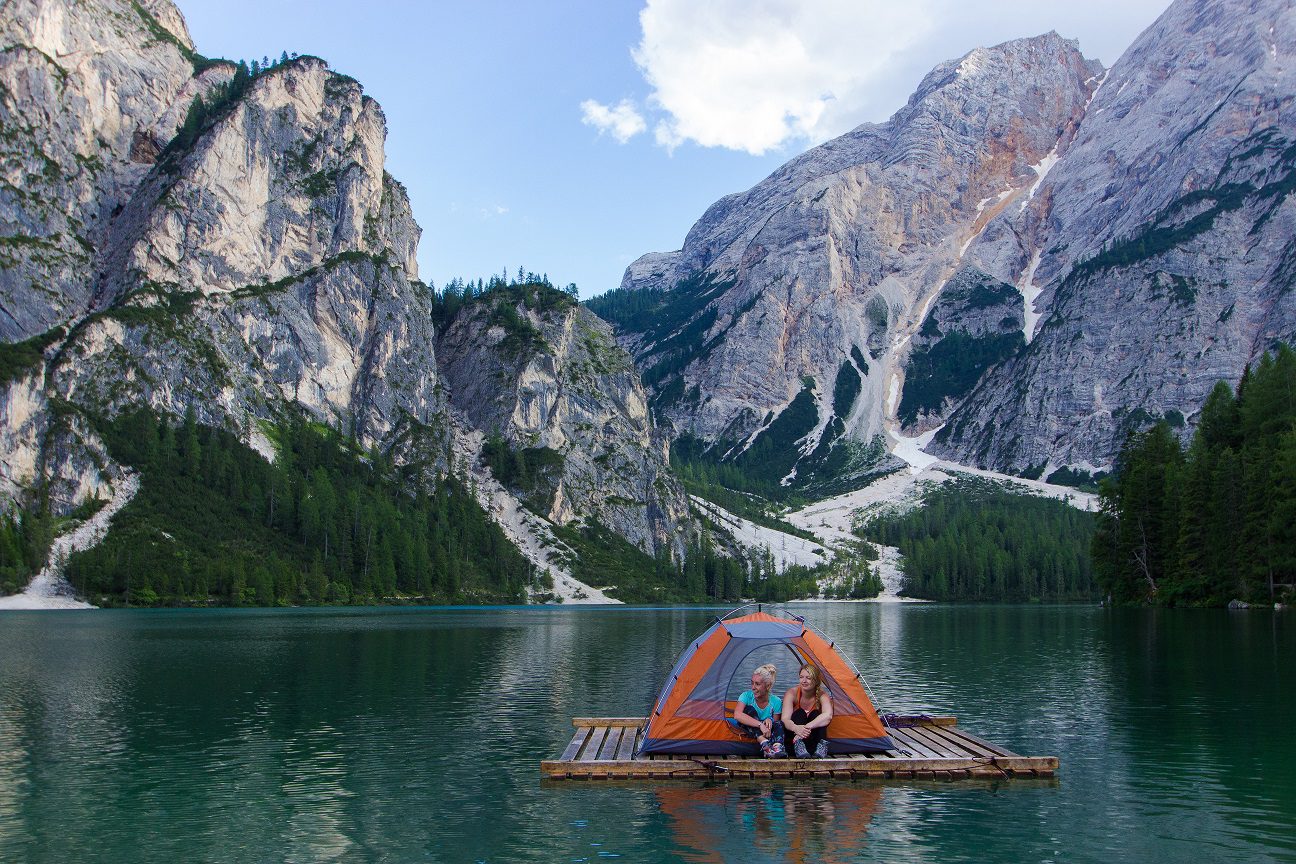If taking the family on a camping holiday is part of the plan this year, how do you choose the right tent from all of those out there? Which features are worth paying for and which will just soak up your holiday spending money? With 50 years of selling tents behind us, here are some of the key things we think you should consider.
1. Size matters – Who’s up for camping? Is this tent going to be for a couple...plus kids...and their friends...brother’s family too...grandma and grandad...and their dogs? Obviously, you can still use a large tent for just a few of you, but the extra space it takes up in the back of the car, the time it takes to set up and, possibly, the extra charge incurred at the campsite for taking up a large pitch, might make you wish you’d gone for a smaller model if that's all you really needed.
Perhaps you could first check out with the rest of the camping-friendly extended family whether they like the idea of sharing one big tent, or clustering smaller tents together for the occasional weekend? And, if you really get to like the camping lark, of course, you could always end up with a smaller tent for spontaneous sunny weekend breaks and a larger one for holidays with all the family?
2. From summer holidays to overnight stops en-route – What will you be using the tent for? If the answer is “for long summer holidays around the UK and around Europe”, then living space is a pretty high priority – space to move around without bumping into each other, space to prepare food and eat it, space for the accessories that quickly become an essential part of your kit, plus - importantly - enough sleeping space for everyone. Yes, if the weather’s great, you’ll be doing a lot more outside the tent, but, when it’s raining, you need your in-tent space. (Did anyone mention rain? All the more reason to get a decent tent!)

BUT...many campers get as much fun out of weekend camping when the weather forecast flags-up the opportunity – and you often don’t have to travel far from home to find a campsite and feel that you’re on a mini-holiday. This is when your tent becomes a really cost-effective jumping-off point for sightseeing, touring the area from your campsite base – or maybe enjoying the hospitality of the local village pub or on-site clubhouse without the need to worry about driving home? If your tent is going to be more of a place to 'rest your head', get changed and go out to enjoy the area, your sleeping space and how the compartments are divided up may take priority over where you’re going to be peeling the spuds.
Then there’s the true overnight stop-over, when your tent’s the alternative to a roadside hotel for the whole family – which can add up when you’re halfway to the South of France and really need to call it a day and get some rest. If this is likely to be one of your camping needs, the speed of setting up an air tent – particularly one with single-point inflation – will be a real bonus, rather than sorting tent poles out in the fading light.
3. Air vs. poled – over the last few years, we’ve seen a move towards inflatable tents, rather than the traditional poled variety – but there are advantages either way.
Air tents are quick to set up and pack away as they can be inflated with a simple hand-pump (that’s usually provided) in perhaps just 10 minutes. Systems with single-point inflation are the simplest and quickest – just one valve to inflate the whole structure, with perhaps just a top-up after a few days to maintain rigidity. But...there’s an on-cost for this convenience – they’re perhaps £150-£500 more to buy than the poled-tent equivalent, and there can be longer-term maintenance issues involving replacement air beams. By comparison, with poled tent set-up, you have to carefully thread each pole through the right loops in the flysheet (they’re often colour-coded to help), anchor them into the holder in the groundsheet and hold each pole in place while someone else applies tension by fixing the guy-ropes in. Yes, a bit fiddly and might take you perhaps 20-30 minutes, depending on the size of your tent, but not that arduous a task to achieve similar rigidity as an air tent, once all the guy-lines are in place. With either design, additional ‘storm-straps’ can also be attached to maintain the shape of the tent in strong cross-winds. As said, poled tents are cheaper to buy – a decent 6-berth family tent package at perhaps £450 - £800. Not a bad outlay for a family holiday?
Modern air tents are impressive, and very popular, but there’s still a place for traditional poled tents, especially if speed of set-up comes secondary to the constraints of the family holiday budget. But their popularity and economies of mass production will continue to bring air tents down in price, so watch out for the right air tent deals to grab a bargain.
4. The right material for the job – how you plan to use your tent will have a bearing on the right type of outer wall – ‘flysheet’ – material to opt for. Generally, totally synthetic Polyester flysheets are lighter weight, so will be slightly easier to handle when setting up camp, plus they’ll pack down to a smaller size when travelling. By comparison, the slightly thicker Poly-Cotton alternative – basically a mix of synthetic and man-made fibres – will be a little heavier to handle, bulk-up a little more when packing away, but will be less likely to collect condensation on the inner surfaces when in use – it ‘breathes’ better and also dries-out faster after it’s rained. This tends to make Poly-Cotton flysheets more durable for longer-term pitching and generally gives them a longer life if looked after properly. Both of these materials will be resistant to the sun’s UV rays, but will naturally fade in colour the more they’re used.
5. Waterproofing – We did mention that it sometimes rains when you’re camping, didn’t we? Well, hand-in-hand with material type goes the waterproof rating for the different grades of material used for the flysheet and groundsheet of your tent. Different Polyester-based materials are scientifically tested for their waterproof properties and graded by what’s known as Hydrostatic Head (HH) - such as ‘3000mm HH’ – with the larger the number, the more waterproof the material. This is a useful way to compare specifications between different manufacturers, particularly as the larger players tend to develop their own materials which are then branded for sole use on their product ranges – for example, Kampa Dometic has its ‘Weathershield’, whilst Vango has its ‘Protex’. Whatever the name, check the quoted HH rating for peace of mind. Remember, the larger the number, the better the waterproofing.
Other factors that affect how your tent will protect you from the elements:
Heat-sealed seams – ensure that water doesn’t permeate through the stitched joins between flysheet panels.
Sealed zips – stop rainwater and draught passing through the tent's door zips.
Sewn-in groundsheets – stop draughts, water splashes and crawling insects from entering the tent, giving it a cosier feel.
Door canopies – protruding over-hangs over entrance doors are really useful in giving you shelter from the rain when going in and out of the tent. They can also provide shade, keeping sunlight off of the tent walls on hot days.
6. ‘A good night’s sleep’ – nothing wears us out more than lack of sleep – especially when you’re out in the fresh air enjoying yourselves! One thing that doesn’t help when you’re sleeping in a tent is the fact that it starts to get light at around 3 am in the morning – yes, it really does – plus light kick-starts the 'Dawn Chorus' of birdsong, which can give you some VERY early mornings! But, some tent manufacturers have now sorted out at least part of the problem by using black-out material for the tent’s sleeping compartments, making it much easier to stay asleep to a decent time. As simple a solution as this is, our tent customers tell us that this is one of their favourite features – especially when they have kids who would otherwise be bouncing off the tent walls from the early hours!
7. Creature comforts – comparing one tent with another on their technical merits is one thing, but don’t forget to weigh-up how comfortable they’ll be to live in for a week or two. Viewing real tents, side by side, is by far the best way, though manufacturers and dealers - such as ourselves - will provide photos and scale drawings giving accurate dimensions, for interior head-height for instance. (If you’re on the tall side, it’s no fun scraping your head against the roof panels all of the time in a low-profile tent!) Some tents just feel ‘more homely’ than others – a combination of their design, outside appearance, their colour, internal layout (particularly where the doors, windows and sleeping compartments are). The right tent for you will often just 'feel right’ – particularly if you include the optional extras of a carpet and footprint for a better-insulated, cosier feel underfoot and to protect your tent’s groundsheet from sharp stones etc. Better still, look out for package deals that bundle these in with the price of the tent.
As well as optional extras like side and porch awnings, annexes and sun canopies that can provide you with extra interior and exterior space to spread out, your in-tent comfort will also depend on the rest of the kit that you take with you – the folding chairs (with as much padding as you have boot-space for), good airbeds or self-inflating mattresses to insulate you from the ground as it cools at night, and good sleeping bags or duvets. Also, there’s no such thing as a ‘fashion-victim’ when it comes to camping... so don’t forget the woolly bed-socks, T-shirts, leggings, husband/wife, shaggy dog – whatever it takes to keep you warm and cosy at night!
Work out how you'll want to use it, do a bit of research, check the prices, buy a good tent and look after it - and you'll have years of healthy, outdoor, sociable fun ahead for the whole family!
-------------------------------------------------------------------------------------
Norwich Camping & Leisure Village, in Blofield, east of Norwich, Norfolk, has one of the UK’s largest outdoor displays of tents and awnings, plus indoor showroom displays of camping & caravanning equipment, outdoor clothing, garden furniture & buildings, barbecues and a fully-stocked garden centre. Barbecue brands in stock: Alfresco Chef; Weber; Napoleon; Outback; Campingaz; Broil King; Char-Griller; Kadai; Grillstream; Masterbuilt; Kamado Joe; Ooni; Traeger; Cadac & Whistler.
The Leisure Village also has a farm shop, coffee shop, new & used campervan sales, professional-standard car, camper & caravan hand-wash station. With 50 years of experience and practical, friendly advice – plus our Best Price / Price Match Policy and low-rate finance terms why not come along and see us!
www.norwichcamping.co.uk Tel: 01603 717600 [email protected] Follow us on Twitter!

 Previous Article:
Previous Article: 





